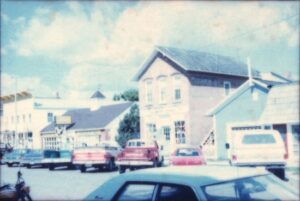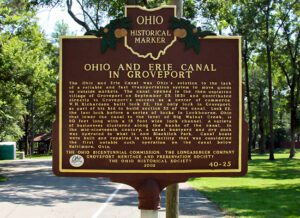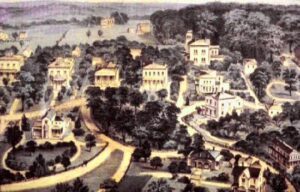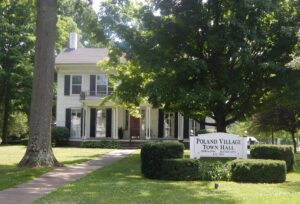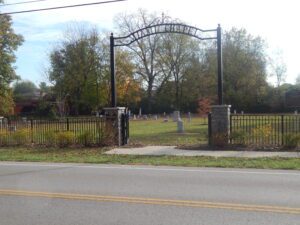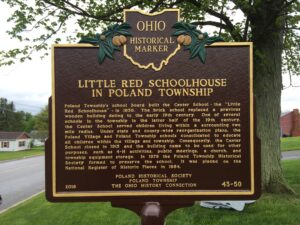, OH
Born in Rhode Island, John Pray (1783-1872) moved to the Maumee River Valley from New York shortly after serving in the War of 1812 and completing a prospecting tour in Ohio. He built a dam across the river to Granger Island and in 1821 constructed a water-powered gristmill, the first on the lower Maumee. In 1831, he laid out the Village of Waterville with the first 50 lots. The Columbian House, a stagecoach inn constructed by Pray in 1828 and expanded in 1837, was for years the commercial and social center of Waterville and accommodated travelers from cities such as Detroit and Cincinnati. From this building, he operated the village’s post office. When Wood County was organized in 1820, Pray became a commissioner until Lucas County was formed from part of Wood in 1835. For nine years he served as Justice of the Peace in Waterville. He and his wife Lucy raised eleven children to adulthood. Circa 1854 he constructed his home, which today overlooks Pray Park.
, OH
The Ohio and Erie Canal was Ohio’s solution to the lack of a reliable and fast transportation system to move goods to outside markets. The canal opened in the then unplatted village of Groveport on September 25, 1831 and contributed directly to Groveport’s success as a center of commerce. W.H. Richardson built lock 22, the only lock in Groveport, as part of his bid to build section 52 of the canal. Lock 22, the last lock before a series of locks in Lockbourne, Ohio that lower the canal to the level of Big Walnut Creek, is 90 feet long with a 15 foot wide lock channel. A variety of businesses clustered along the banks of the canal. In the mid-nineteenth century, a canal boatyard and dry dock was operated in what is now Blacklick Park. Canal boats were built and repaired in this facility that was considered the first notable such operation on the canal below Baltimore, Ohio.
, OH
Established in 1851 after the addition of the Cincinnati, Hamilton, and Dayton Railway, Glendale incorporated in 1855 as Ohio’s first planned community and one of the nation’s first planned villages. The original planning included forested greenbelts and parks, curvilinear streets meandering around established trees, large lots, and superior building standards. Glendale is designated as a National Historic Landmark community from the Department of Interior and a Certified Local Government through the Ohio Historic Preservation Office, all owed to Glendale’s persistent adherence to the plan and faithful preservation of original infrastructure. Much of today’s preserved infrastructure includes the original 59 pivotal buildings, curvilinear streets, tree canopy, stone gutters, gas streetlights, and railroad depot.
, OH
The Erie Terminal Building, constructed 1921-1922, serviced both the Erie and Pittsburgh & Lake Erie Railways and area commerce. The design, by Swiss-born, Youngstown architect Paul Boucherle (1882-1966), is in the Commercial Style with simple classical details. The six-story building housed a passenger railroad station on the first floor and Erie Railway offices on the fifth and sixth floors. A one-story commercial bay faced Commerce Street and was the home of the International Bank and later the Morris Plan Bank. The widening of Commerce Street removed the bay in 1939. Once named the Hamory Building for its financial backer, Gustave Hamory, it was added to the National Register of Historic Places in 1986 and renovated in 2012, creating apartments in the upper floors and restoring the first-story railway spaces.
, OH
The Village of Poland officially incorporated in August 1866, a year after the end of the Civil War. In April 1867, the citizens elected John Leslie as mayor. As of 1880, Poland’s population exceeded 400. Through its history, the village has consisted of a four-acre village green, churches, schools, hotels, a sawmill, gristmill, post office, tannery, and foundry, as well as carriage, tin, and cabinet shops; drug, dry goods, and hardware stores, and doctors, blacksmiths, and shoemakers. Residents swam in and skated on Yellow Creek. The Poland Municipal Forest was established in 1938 and annexed later as the Village continued to grow. In 1966, the residents held a three day Centennial Celebration, featuring an address by Governor James Rhodes. The centennial year also saw the publication of a history of Poland and the restoration of Centennial Gardens.
, OH
Around 1843, local Methodists organized a new Methodist Episcopal church at Fair Play and later erected a brick chapel. The congregation was short-lived, however, and fell into decline after one of its leading members, Joseph Lashorn, moved to Hamilton. In 1876, Reverend F. G. Grigsby of the United Brethren church organized a congregation here, repairing and occupying the old Methodist chapel for the next several years. The cemetery is the burial place for veterans from the Revolutionary War, War of 1812, and Civil War; some of whom are interred in unmarked graves. The last known burial was Etta Thomas in 1941.
, OH
The ARK in Berea is the first structure in Cuyahoga County to incorporate sustainable building concepts from the Earth Summit in Rio de Janeiro in 1992. Hand built in 1994 as a work of art by environmental artists David and Renate Jakupca, it is a study for future buildings for the Headquarters of the International Center for Environmental Arts (ICEA) and Eco Village. A hybrid structure utilizing cob, straw bales, aluminum cans, used tires, and recycled construction materials, the ARK (Architektur Recycled Kulturstall) helps to address the environmental problems of large urban areas and the trend of rebuilding rather than remodeling existing structures. The ARK is used as a museum, community center, and art studio of David Jakupca.
, OH
Poland Township’s school board built the Center School- the “Little Red Schoolhouse”- in 1858. The brick school replaced a previous wooden building dating to the early 19th century. One of several schools in the township in the latter half of the 19th century, the Center School served children living within a surrounding two mile radius. Under state and county-wide reorganization plans, the Poland Village and Poland Township schools consolidated to educate all children within the village and township. Consequently, the Center School closed in 1915 and the building came to be used for other purposes, such as 4-H activities, public meetings, a church, and township equipment storage. In 1979 the Poland Township Historical Society formed to preserve the school. It was placed on the National Register of Historic Places in 1984.


